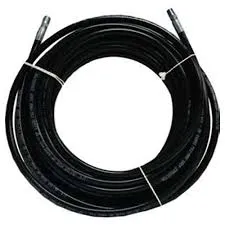hose pipe coupling joint
Understanding Hose Pipe Coupling Joints Essential Components for Fluid Transfer Systems
In various industries, including agriculture, construction, and manufacturing, the ability to transfer fluids efficiently and safely is paramount. One of the critical components that facilitate this fluid transfer is the hose pipe coupling joint. This device connects hoses or pipes to ensure a secure and leak-free connection, enabling the movement of liquids or gases. Understanding the different types of hose pipe coupling joints and their applications is essential for anyone involved in fluid handling systems.
What is a Hose Pipe Coupling Joint?
A hose pipe coupling joint is a mechanical device used to connect two hose sections or a hose to a piece of equipment, such as a pump, valve, or another hose. These joints are designed to withstand various pressures and are made from a variety of materials including metal, plastic, and rubber, depending on the specific application and fluid being transported. The primary purpose of a coupling joint is to create a reliable seal that prevents leaks while allowing for quick and easy disconnection when necessary.
Types of Hose Pipe Coupling Joints
Hose pipe coupling joints come in numerous designs and configurations to accommodate different applications. Some of the most common types include
1. Threaded Couplings These feature internal or external threads that allow hoses to be screwed together. Threaded couplings provide a strong, leak-proof connection but may require tools for tightening and loosening.
2. Quick Couplings Quick couplings are designed for easy attachment and detachment without the need for tools. They are commonly used in industries where hoses need to be frequently connected and disconnected, such as in agricultural spray applications or automotive scenarios.
3. Cam and Groove Couplings Also known as cam locks, these fittings consist of two parts a male adapter and a female coupler. They connect by placing the male part into the female part and securing it with a cam arm. This design allows for quick connections while providing a secure seal, making them popular for transferring liquids in chemical and food processing.
4. Barbed Couplings Barbed couplings allow hoses to be slipped over a barbed fitting, often secured with a clamp. This design is prevalent in low-pressure applications due to its simple assembly and cost-effectiveness.
5. Push-to-Connect Couplings These innovative couplings allow a hose to be connected simply by pushing it onto the fitting. They are widely used in pneumatic systems and have become increasingly popular in both industrial and residential applications.
hose pipe coupling joint

Selecting the Right Hose Pipe Coupling Joint
Choosing the appropriate hose pipe coupling joint is crucial for maintaining system integrity and functionality. Several factors should be considered when making this decision
- Fluid Type The nature of the fluid being transported—whether it's water, oil, chemicals, or gases—affects the choice of materials and the type of coupling. For instance, corrosive liquids require specialized materials that resist degradation.
- Pressure Rating Each coupling joint has a specific pressure rating. Ensuring that the selected joint can handle the maximum pressure within the system is critical to avoid failures.
- Temperature Range Couplings must also withstand varying temperatures of the fluid being transported. High temperatures can weaken certain materials, so it's essential to choose joints designed for the specific thermal conditions.
- Connection Type Consider how frequently connections will be made. If quick disconnection is essential, quick couplings or push-to-connect options may be the best choice.
- Size Compatibility Ensure the coupling joint's size fits the hoses or pipes being used. Mismatched sizes can lead to leaks and system failures.
Maintenance and Best Practices
To ensure the longevity and effectiveness of hose pipe coupling joints, regular inspections and maintenance are necessary. Check for wear, corrosion, and any signs of leakage. It is also advisable to replace seals and gaskets periodically to maintain a secure connection.
In conclusion, hose pipe coupling joints play a critical role in the efficient transfer of fluids in various applications. By understanding the different types available, how to select the right one, and the importance of regular maintenance, users can ensure safe and effective fluid handling systems. Whether in an industrial setting or at home, these components are integral to achieving reliable fluid transfer.
-
Ultimate Spiral Protection for Hoses & CablesNewsJun.26,2025
-
The Ultimate Quick-Connect Solutions for Every NeedNewsJun.26,2025
-
SAE J1401 Brake Hose: Reliable Choice for Safe BrakingNewsJun.26,2025
-
Reliable J2064 A/C Hoses for Real-World Cooling NeedsNewsJun.26,2025
-
Heavy-Duty Sewer Jetting Hoses Built to LastNewsJun.26,2025
-
Fix Power Steering Tube Leaks Fast – Durable & Affordable SolutionNewsJun.26,2025

